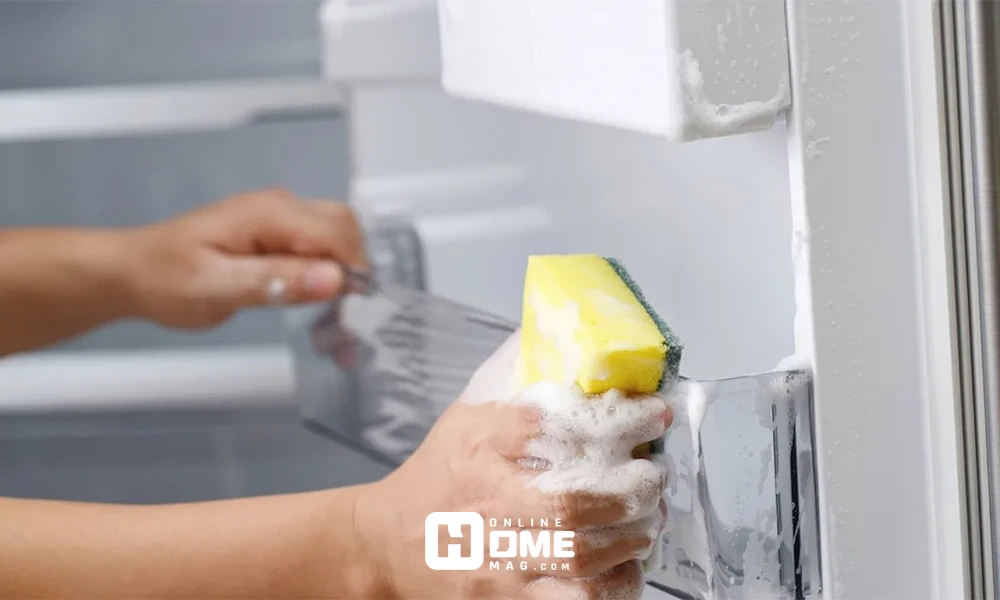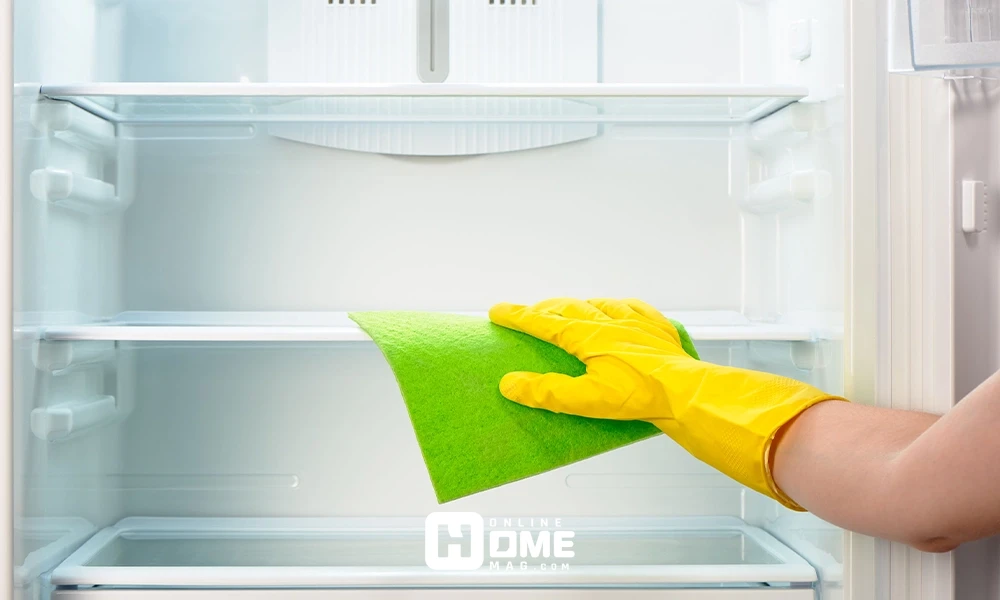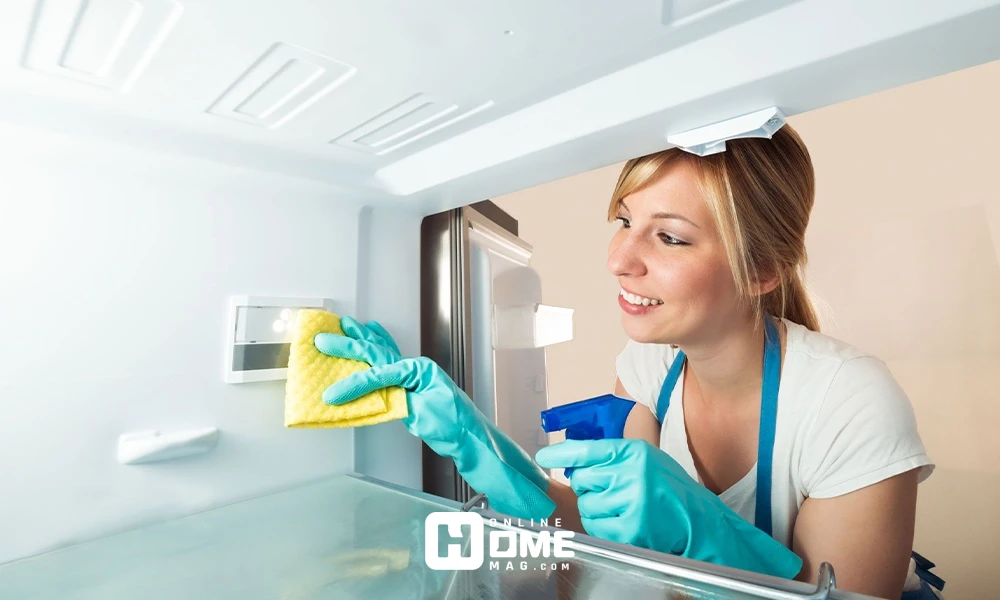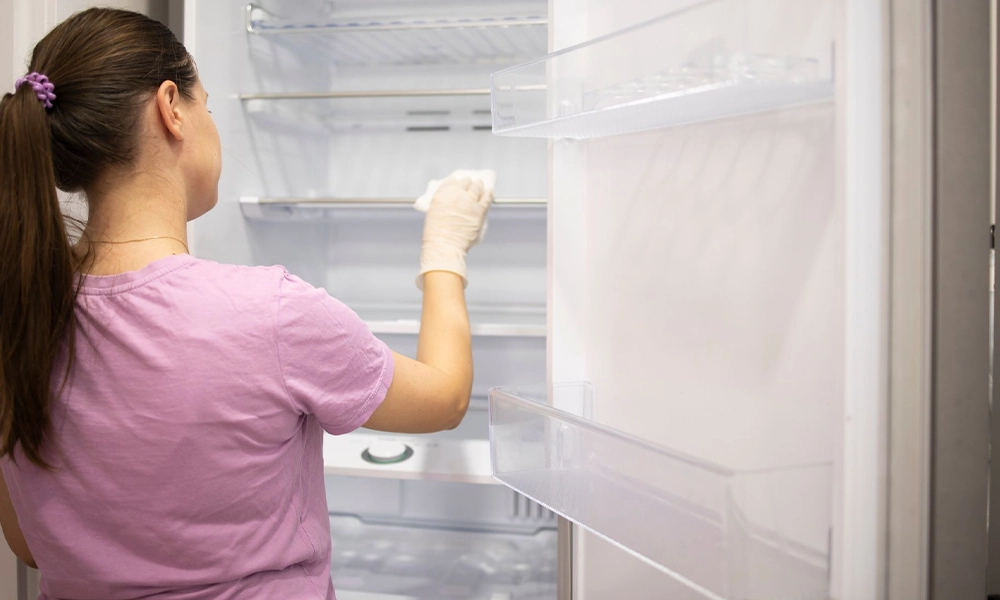🕓 Last updated: October 21, 2025
How to clean your refrigerator
Cleaning your refrigerator doesn’t have to be complicated — with a step-by-step plan, it can be done quickly and effectively. Start by unplugging your refrigerator to ensure safety while cleaning. Then, remove all food items, checking expiration dates as you go. Toss anything expired or spoiled to avoid contamination and bad odors.
Next, take out shelves, drawers, and compartments, and wash them separately with warm, soapy water. Use a soft sponge or cloth to prevent scratches. For the inside of the fridge, make a cleaning solution using equal parts of white vinegar and warm water. This natural mix helps disinfect and neutralize odors without harsh chemicals, and you can also use a homemade house cleaner for a more personalized touch.

Wipe all interior surfaces, including the walls, door seals, and corners where spills often collect. Use a toothbrush or small brush to clean tight spots and seams. Finally, dry everything with a microfiber cloth before reassembling the shelves and returning the food.
Quick cleaning tips:
• Unplug before cleaning for safety.
• Wash removable parts with mild soap.
• Use vinegar-water solution or homemade house cleaner for the interior.
• Dry thoroughly to prevent moisture buildup.
A regular routine of cleaning your refrigerator ensures a fresh-smelling and hygienic space for storing food.
How often should you clean your fridge? Cleaning your refrigerator
Cleaning your refrigerator regularly is essential to maintain hygiene, prevent the buildup of bacteria, and ensure that your food stays fresh for as long as possible. A clean fridge helps eliminate odors and reduces the risk of cross-contamination between different food items. The frequency with which you clean your refrigerator will depend on your usage and how often spills or food items expire. Ideally, deep cleaning should be done every three to four months, but you can incorporate simple, quick cleaning tasks into your weekly routine to keep it fresh.
Here’s a quick guide for fridge cleaning frequency:
- Daily: Wipe up spills immediately to prevent staining or mold buildup.
- Weekly: Check expiration dates and dispose of spoiled or expired food.
- Every 3-4 months: Deep clean the interior, including shelves, drawers, and door seals.
A House Cleaning Checklist can be a helpful tool to track these tasks and ensure your refrigerator is cleaned consistently. Remember, a regular cleaning schedule helps prevent the accumulation of grime and odors, making your fridge a healthier and more pleasant environment for storing food. Regular maintenance also ensures that when the time comes for a deep clean, the task will be much quicker and easier. By staying on top of these tasks, your fridge will remain fresh and functional for longer.
What to use to clean a fridge
When it comes to cleaning your refrigerator, choosing the right cleaning tools and products can make the process much easier and more effective. While many people use basic supplies like warm water, dish soap, and vinegar, there are also specialized tools and products that can help achieve a deeper clean.

For general cleaning, a mix of equal parts white vinegar and warm water works wonders. It’s natural, effective, and helps neutralize odors while disinfecting. However, for tough stains or mold, you might want to consider a Steam Cleaner for Home. Using steam can help break down grease, stubborn stains, and bacteria without the need for harsh chemicals. It’s an excellent tool for cleaning the fridge’s interior, especially around tight spaces and corners where mold or grime can accumulate.
Quick tips:
- Use a mild dish soap for removable shelves and drawers.
- A microfiber cloth works best for drying and wiping.
- Steam can effectively clean hard-to-reach spots and sanitize areas.
By using the right cleaning products and tools, you’ll ensure your fridge is not only spotless but also safe for food storage. Regular use of these cleaning methods can help maintain a fresh, hygienic fridge without much hassle.
| Cleaning Tool/Product | Purpose | Benefits |
| White Vinegar & Warm Water | General cleaning, neutralizing odors, disinfecting | Natural, effective, safe for food storage |
| Steam Cleaner for Home | Tough stains, mold removal, hard-to-reach spots | Chemical-free, deep cleaning, sanitizing |
| Mild Dish Soap | Washing removable shelves and drawers | Gentle on surfaces, removes dirt effectively |
| Microfiber Cloth | Drying and wiping the fridge surfaces | Absorbs moisture, prevents streaks and residue |
The best way to clean a refrigerator
Cleaning your refrigerator thoroughly can extend its lifespan, improve food safety, and eliminate unpleasant odors. The best method involves a combination of natural cleaning solutions, proper techniques, and some patience. Here’s a step-by-step guide for a thorough fridge cleaning:

- Unplug the Refrigerator: For safety, always unplug your refrigerator before starting the cleaning process.
- Remove All Items: Take out all food and check for expired or spoiled items. This is a great opportunity to declutter and organize.
- Take Out Shelves and Drawers: Remove all shelves, drawers, and compartments. Wash them separately with warm soapy water. Use a soft sponge to avoid scratching.
- Clean the Interior: Make a cleaning solution with equal parts white vinegar and warm water. Use this to wipe the interior walls, door seals, and shelves. For stubborn stains, use a small brush or a toothbrush to scrub tight spots.
- Clean the Coils and Underneath: If possible, vacuum or brush the coils and clean underneath the fridge. Dust and debris can accumulate here, reducing the efficiency of your fridge.
- Dry Thoroughly: Use a microfiber cloth to wipe away any moisture from surfaces. Moisture left behind can cause mold or mildew growth.
- Reassemble and Organize: Once everything is clean and dry, reassemble the shelves and drawers, and organize the food properly to ensure better airflow inside the fridge.
Quick Tips:
- Clean your fridge every 3-4 months for a deep clean.
- Regularly wipe up spills to prevent stains.
- Use vinegar to eliminate odors and bacteria naturally.
- Dry surfaces well to prevent mold buildup.
By following these steps and using the right tools, your fridge will stay fresh and functional for longer, helping keep your food safe and clean.
How clean the inside of the refrigerator
Keeping your refrigerator clean isn’t just about appearance — it helps your food stay fresh longer and prevents bad odors. A clean fridge also makes it easier to organize your groceries and spot what you actually have. By taking a little time once a month to wipe and disinfect, you can avoid bacteria buildup and keep everything hygienic. Here’s a simple, step-by-step guide to get it done easily.
- Empty Everything Out
Remove all food items and check expiration dates. Throw away anything that’s spoiled or has been sitting too long. - Remove Shelves and Drawers
Take out shelves, drawers, and door bins. Wash them with warm water and mild dish soap, then let them dry completely. - Wipe the Interior
Mix 2 tablespoons of baking soda with 1 liter of warm water. Use a sponge or cloth to clean all interior surfaces — walls, doors, and seals. - Handle Tough Stains
For sticky or dried spills, apply the baking soda mix and let it sit for a few minutes before wiping. Avoid abrasive tools that may scratch surfaces. - Dry and Reassemble
Use a dry microfiber cloth to remove any moisture. Put shelves and drawers back in their place once fully dry. - Organize Neatly
Keep similar items together and store raw meat on the lowest shelf to prevent leaks or contamination. - Keep It Fresh
Leave an open box of baking soda in your fridge to absorb odors and replace it every 3 months.
Cleaning your refrigerator regularly keeps your food safe and your kitchen smelling fresh. It’s a quick task that makes a big difference in hygiene and organization. Set a reminder to do it monthly — your future self will thank you!
Remove food, shelves and drawers from the fridge
Before you start, unplug your fridge to clean it safely. Take out all the food, checking expiration dates and tossing anything old or spoiled. Next, remove the shelves, drawers, and door bins carefully — these parts usually collect spills and crumbs over time. Wash them separately with warm, soapy water and let them dry completely before putting them back. This step is one of the most important parts of how clean refrigerator properly, because it allows you to reach every corner and remove hidden dirt or bacteria.
Clean underneath the fridge
Many people forget about the space under the fridge, but it collects dust, crumbs, and sometimes even pet hair that can affect performance. Unplug your refrigerator and carefully move it forward — just enough to reach behind and underneath. Use a vacuum or a long-handled brush to remove all dust and dirt from the floor and coils. If the area is sticky, wipe it with warm soapy water and let it dry completely. Cleaning underneath the fridge every few months helps it run more efficiently and prevents unpleasant odors in your kitchen.
Clean outside of the fridge
The exterior of your fridge deserves attention too. Dust, fingerprints, and food splatters can make it look dull over time. To keep it shiny, mix a little dish soap with warm water and wipe the surface using a soft cloth. For stainless steel models, always wipe in the direction of the grain to avoid streaks. Don’t forget to clean the handles — they collect germs easily. Finish by drying with a microfiber towel for a polished look. This simple step is part of how clean refrigerator completely and keeps your kitchen looking fresh and hygienic.
How to clean mold from a fridge
Finding mold inside your fridge can be unpleasant, but it’s a common problem that usually happens because of moisture or forgotten food. The good news is, cleaning it is simple and only takes a few steps.
Step 1: Unplug and Empty the Fridge
Start by unplugging the refrigerator for safety. Take out all food, shelves, and drawers. Throw away anything that has visible mold or an unusual smell — mold spores spread quickly in cold, damp areas.
Step 2: Make a Cleaning Solution
You don’t need harsh chemicals. Mix equal parts of white vinegar and warm water in a spray bottle. Vinegar naturally kills most types of mold and removes odors. For tougher spots, add a spoon of baking soda for extra power.
Step 3: Spray and Scrub
Spray the solution directly on moldy areas, especially around door seals, corners, and walls. Let it sit for 10 minutes, then gently scrub with a sponge or an old toothbrush to reach tight spaces.
Step 4: Rinse and Dry
Wipe everything with a damp cloth to remove any residue, then dry completely with a towel. Moisture helps mold regrow, so make sure every surface is dry.
Step 5: Clean Shelves and Drawers
Wash all removable parts with warm soapy water, rinse, and dry them thoroughly before placing them back inside.
Step 6: Keep It Mold-Free
To prevent mold from coming back, keep your fridge temperature below 4°C (40°F) and clean it monthly. Always wipe spills immediately and store food in sealed containers.
By following these steps, you’ll easily master how to clean mold from a fridge and keep your refrigerator smelling fresh, spotless, and safe for your food.
How to remove stains from inside a fridge
Stains inside a refrigerator are almost unavoidable — spills, sauces, and fruits can easily leave marks that build up over time. The key to keeping your fridge spotless is cleaning stains as soon as they happen and giving the interior a deep clean once a month.
Step 1: Unplug and Empty the Fridge
Before cleaning, unplug the fridge and take out all food, shelves, and drawers. This helps you reach every corner safely. Throw away any spoiled items to prevent odors from returning later.
Step 2: Choose a Gentle Cleaner
Avoid strong chemicals that can leave harmful residues near your food. Instead, mix two tablespoons of baking soda with one liter of warm water. This natural cleaner lifts stains and neutralizes odors without damaging the surface. For stubborn stains, use white vinegar or lemon juice — both are powerful yet safe options.
Step 3: Wipe and Scrub
Dip a soft sponge or microfiber cloth in your cleaning solution and gently scrub stained areas. For sticky or dried spills, apply the cleaner directly and let it sit for 10–15 minutes before wiping. You can use an old toothbrush for narrow corners or textured surfaces.
Step 4: Rinse and Dry
Once the stains are gone, wipe all surfaces with clean water to remove any residue. Then, dry everything completely with a soft towel to prevent moisture buildup.
Step 5: Reassemble and Organize
Put the clean shelves and drawers back, and arrange your food neatly.
By following these simple steps, you’ll learn how to remove stains from inside a fridge easily — keeping it fresh, hygienic, and looking like new every time you open the door.
Last Word
Keeping your fridge clean, stain-free, and mold-free is essential for food safety and a fresh kitchen. By following simple steps like removing food, scrubbing surfaces, and regular maintenance, you can make cleaning easier and more effective. For more tips and practical advice on home care, check out ONLINE home mag for expert guidance and inspiration.


